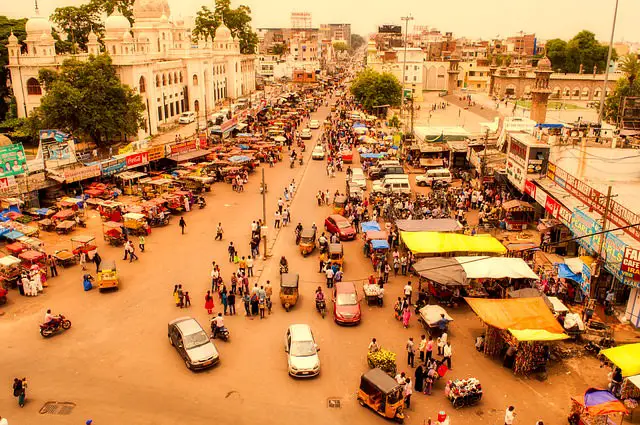Religious Infrastructure in the Urban: An Introduction
Centres of religious worship in the forms of temples, mosques and mazaars have been around for centuries. They have witnessed various levels of incrementality in their vicinity. Most of them have seen completely new cities crop up all around them. Today, these centres claim a space for themselves in the cities. They are justified on the ground of heritage, social activity or presence of a large number of devotees; however, their legitimacy gets diminished when a developmental plan is implemented and suddenly the ground on which a temple stands, is snatched away to widen the road or build a metro pillar, and the like. This is the reality of our cities. Religious structures are revered one moment, and the next they can vanish. The places I visited in Hyderabad made this phenomenon come to light, in my mind.
The case study of Lakdi ka Pul, Hyderabad
My field site in Hyderabad was a place called Lakdi ka pul. It was a busy commercial centre which had a place for big businesses as well as small venders. The site seemed like a perfect blend of the old and the new; mosques and mazaars standing as tall as the buildings. One of the first things I observed was mazaars in the middle of the footpath. Judging by the lens of incrementality I presumed these structures came up after the footpath was constructed. Upon enquiry I realised that I was wrong. The mazaars had been there as centres of worship long before the footpaths came in. Interestingly, the footpath did not consider the mazaar to be an impediment, and so adjusted itself around it. Incrementality was therefore the footpath, and not the mazaar.
I was interested to know how people viewed the presence of something devotional in the midst of something that has become so commercial, like the Lakdi ka Pul. I talked to two men, both of whom had subtly presented two different ways of looking at the mazaar.

The first man runs a tyre repair shop and seemed welcoming to me and the questions I posed. He told me that he had been running his shop in the marketplace for more than 50 years now and the mazaar predates him. An annual luncheon is organised by the gentleman who runs it. Everyone, especially the poor, are fed on that day. The man, it seemed, was proud of the mazaar; it was not just a place of devotion and god, but a place for common people as well.
The other man I met was an auto driver who looked after the mazaar. He was responsible for the cleaning and security of the structure. All this man said was that “yeh to bade sahib (pir) ki jagah hai, iske baare me kya bole”. This man considered the mazaar to be so sacred that he refused to divulge any information about it.
Since I am recounting conversations, I believe another interesting conversation should be mentioned here. Inside the MMTS station there is a mosque. The man who works in the parking lot told me categorically that “chahe koi bhi development ho yeh (mosques) yahi rahenge.” He was sure that no matter which plan comes up, the mosque and its space will forever be dedicated to religion and its manifestations.
These three conversations about religious space in a commercial arena expressed one common sentiment, religious structures have permanent claims over the space they occupy. But my question is, is this permanence respected by the authorities? Can people truly decide if the religious place is permanent, once the decision to bring them down by the authorities has been taken?
Comparison with the Financial District of Hyderabad
Another site that I visited in Hyderabad was the Financial District. It boasted of big glass buildings which belonged to multinational companies. Fresh constructions are underway to create more such mammoth buildings. In the midst of these constructions, I saw a 400-year-old temple. It was colourful and bright with a shikhar, a true representation of south Indian temples. Parts of this temple had been destroyed and this might continue in the future if it gets in the way of constructing a new glass building. Surely, the devotees of this temple must have assumed it would be here permanently, but this assumption has been proven wrong. The claim on space this religious structure made is no longer considered legitimate.
It seemed to me that time and money decide the presence of religious structures. If the space it occupies is claimed by something which can boost in more money, down comes the structure. Or if the time is such that devotion is undermined before the economy, the religious structure gets no chance at all. In the Financial District both these factors are coming to play, therefore the devotional or historical character of the temple is failing to save it from destruction. At Lakdi ka pul on the other hand, these two factors are absent as of now and so the mazaars and mosques seem safe and permanent. Actually, who knows, maybe the people there can negotiate successfully and save their centres of worship.
All I can say right now is that religious structures like these are a part of the urban. They claim a space and many a time, become harbingers of economic and social activities too. However, their fate is decided by the next developmental plan. Who knows, whether the next set of footpaths or roads in Lakdi ka pul would consider the mazaars impediments or not.
Author Bio: Milan is a student of Urban Policy and Governance in TISS. Previously, she studied Political Science from the University of Delhi. She is keen in looking at governance issues in the realm of Indian Urbanisation. She is also an avid reader of all things literary and historic.